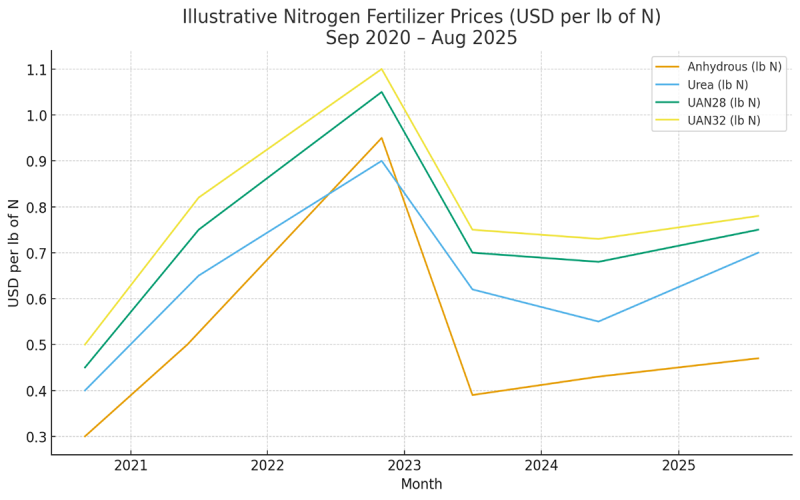
Nitrogen (N) fertilizer prices have been highly unpredictable in recent years, and after months of fluctuation, they have surged again over the past month (Figure 1). With fertilizer representing one of the largest variable costs in wheat production, inefficient N use can quickly erode profit margins. In fact, research in South Dakota and other Great Plains states show N fertilizer use efficiency in cereals is often below 40%, meaning most of the N applied never ends up in harvested grain (Sowers et al., 1994). This being said, an emphasis should be placed on how to improve nutrient management during the 2026 growing season, especially with fall planting of winter wheat starting in some areas of South Dakota. This article reviews recent South Dakota research on N response in winter wheat, explores ways to improve fertilizer use efficiency, and outlines how growers can balance yield, protein, and profitability in the 2026 growing season.
South Dakota Research
In 2023 and 2024, SDSU researchers conducted winter wheat N response trials at Wall and Sturgis under no-till conditions. Pre-season soil N was measured, and four rates of N fertilizer (0, 50, 100, and 150 lbs./N acre) were applied. Results were fit to a model which illustrates optimal N rate in wheat, and the point in which added N resulted in a yield response that was minimal or zero. Key findings were as follows:
- At Sturgis in 2023, yield plateaued at 61 bushels/acre with 135 lbs. total N (soil + fertilizer) producing an economic return of $0.84 (assuming $6/bushel wheat) per pound of applied N (Figure 2).
- At Wall in 2023, yield plateaued at 51 bushels/acre with 115 lbs. total N, returning roughly $1 per pound of N (Figure 3)
- At Sturgis in 2024, there was no yield response to applied N. This suggests that residual soil N was sufficient to meet crop demand (Figure 4).
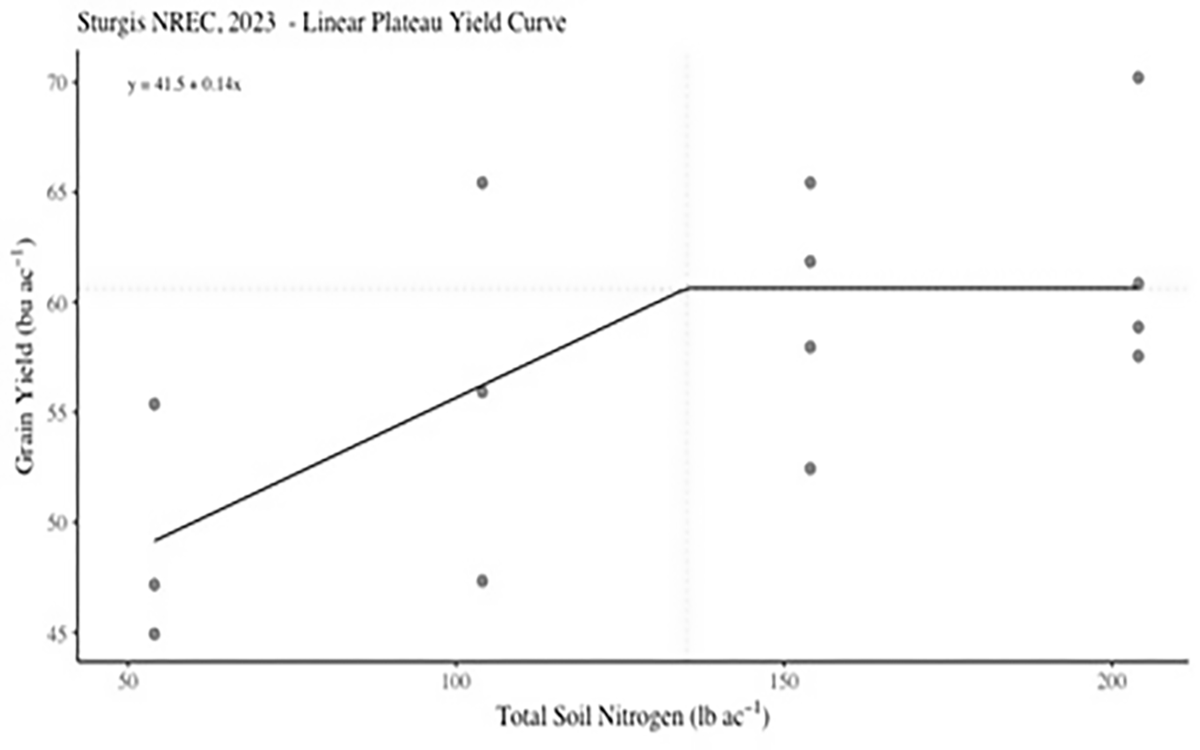
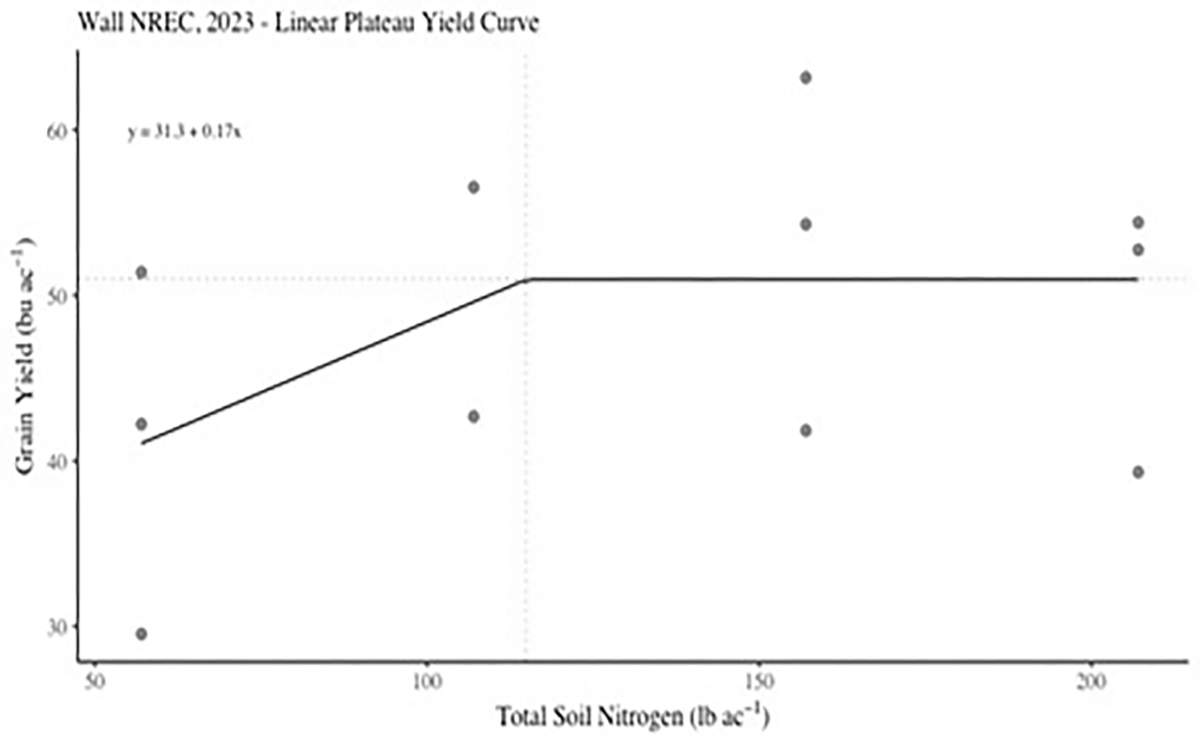
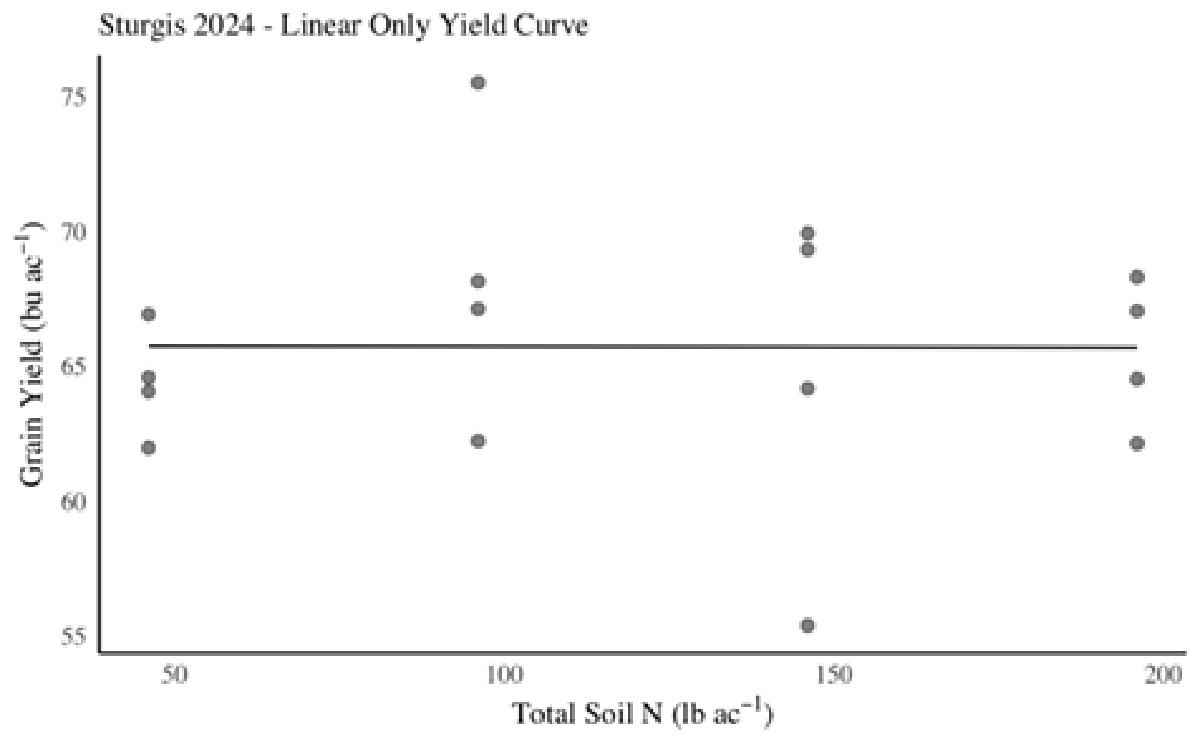
The above results clearly show two scenarios- in some years, yield response to added fertilizer is observed, while in other years, residual soil N and favorable environmental conditions can fulfill the crop’s nutrient requirements. Flat rate applications may carry a high risk of economic loss when variability is high.
Fertilizer Use Efficiency and ROI
In responsive years, fertilizer recovery in our studies averaged only 30-40%. This aligns with USDA-ARS and regional university research that show cereals often recover less than half of applied N (Naser et al., 2020; Thomason et al., 1997). At current fertilizer costs ($0.60-$0.80/lb. N) these efficiency rates make it difficult to achieve a positive return on investment. To improve ROI, N management must account for both residual soil N and crop demand. Testing soil is the first important step in nutrient management plans. Soil test results need to be accounted for when using SDSU Fertilizer Recommendation Guide, while recognizing year-to-year variability in response.
Precision Agriculture
Using precision agriculture concepts have been shown to improve ROI and fertility efficiency. The main concepts outline right place, time, source, and amount. To achieve these concepts, combining spatial variability and crop yield in the form of a yield map will provide insight into problematic areas within a field. Once these problem areas are identified, soil samples can be collected to determine the general fertility that is present there. Pairing this information, a farming operation can avoid under or over fertilization and provide the most efficient outcome for your wheat crop.
Fertilization Methods
Split applying nitrogen in wheat is a common practice that can help with N use efficiency and economic decision making. Traditionally, this practice is completed to avoid excessive tillering in the fall, and to ensure nutrients are available in the spring, when the plant nutrient needs are high. This practice can also be beneficial from an economic perspective. For example, if a smaller dose of N fertility is used at planting when the N demand is low, and if the N prices subside the next year when demand is high while the crop has had ideal environmental conditions, a second application of N can be applied. This will inevitably increase ROI and fertilizer efficiency, while simultaneously aligning with the physiological response that is typical of a wheat crop. Additionally, crop varieties including winter wheat can have varying levels of nutrient use efficiency, which can contribute greatly to N fertilizer savings. A study on variety specific yield response to N is ongoing at SDSU.
Protein Content
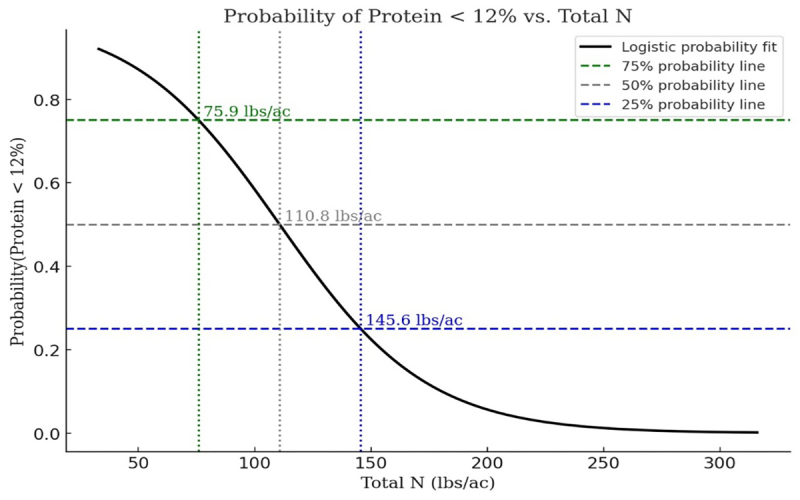
Protein content is one of the most important characteristics in wheat, which directly affects market value, with most elevators requiring a minimum of 12% for winter wheat. Wheat protein below this level can lead to dockage (price penalty), while exceeding 12% may qualify for premiums. In a comparative study across Vivian, Wall, and Sturgis over 14 site-years, higher N rates generally increased grain protein. When applying this information to a probability model (Figure 5), an N application “floor” can be established that outlines the minimum amount of N needed to achieve 12% protein.
- At 76 lbs. total N/acre (residual soil N + applied N) provides a 25% chance of attaining 12% protein.
- At 111 lbs. total N/acre, there is a 50% chance of reaching 12% protein
These findings underscore the importance of N provision at the right time to meet adequate protein, while also establishing minimum application requirements for 12% benchmark. The N supplied later in the growing season is not only helpful in protein enhancement but also meets other physiological need of a growing wheat crop.
The economic outlook for the 2026 growing season is poor when considering the price of grain commodities and the soaring cost of inputs. Producers cannot control fertilizer or grain markets, but they can control how efficiently N is used on their farms. Some key strategies for 2026 include:
- Testing soils and accounting for residual N
- Using precision agriculture tools to target applications
- Utilize split applications to manage both yield and protein values
By integrating local research results, precision tools, and crop physiology insights, growers can reduce risk, protect margins, and make the most of every dollar spent on fertilizer.
References
- Naser, M. A., Khosla, R., Longchamps, L., & Dahal, S. (2020). Characterizing Variation in Nitrogen Use Efficiency in Wheat Genotypes Using Proximal Canopy Sensing for Sustainable Wheat Production. Agronomy, 10(6), 773. https://doi.org/10.3390/agronomy10060773
- Sowers, K. E., Pan, W. L., Miller, B. C., & Smith, J. L. (1994). Nitrogen Use Efficiency of Split Nitrogen Applications in Soft White Winter Wheat. Agronomy Journal, 86(6), 942–948.
- Thomason, W. E., Raun, W. R., Johnson, G. V, Phillips, S. B., & Westerman, R. L. (1997). Winter Wheat Nitrogen Use Efficiency in Grain and Forage Production Systems.


